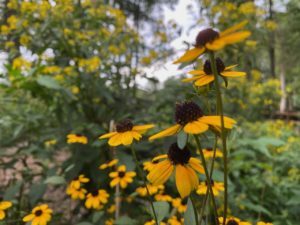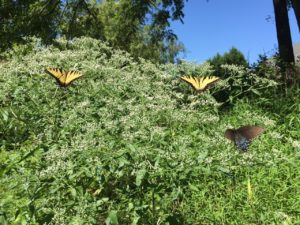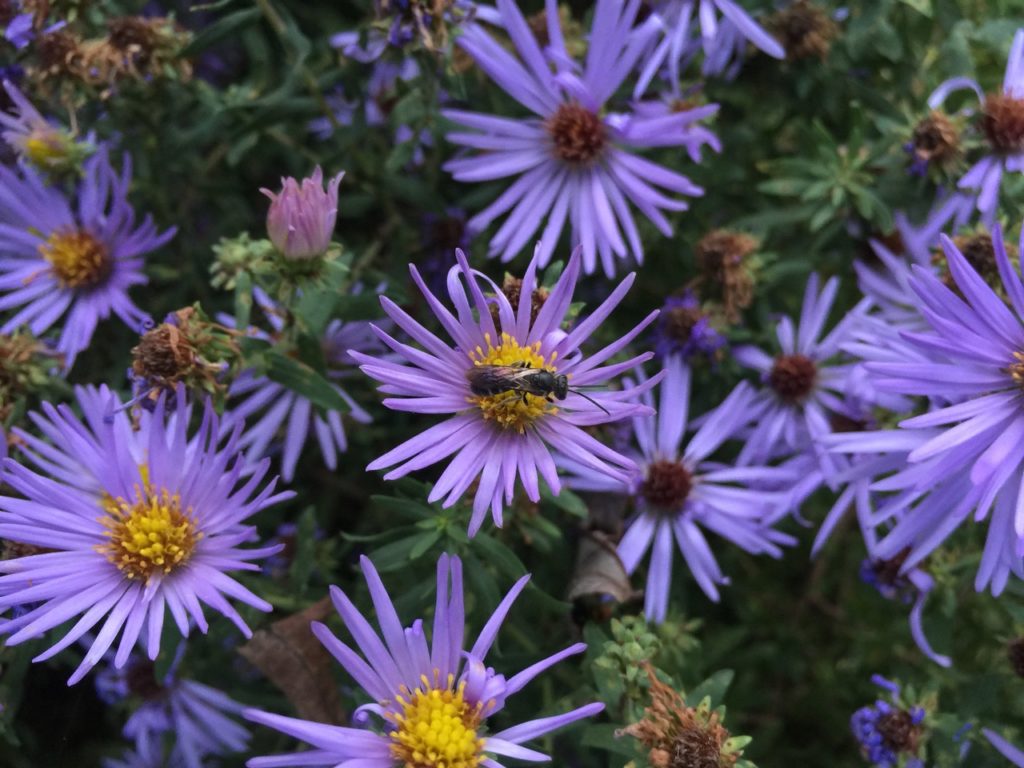Why Use Native Plants in Your Yard
There’s been a lot of talk recently about using native plants for landscaping. But many people are left wondering “why?” Most of us grew up with yards filled with peonies, asian azaleas, nandinas, English boxwood and ivy. We’re comfortable with them. Why shouldn’t we use what we know and love?
Somewhere in the 1950s and 60s, the imported plants that had been exotic became the norm in American landscaping, and we started to forget about the thousands of amazing plants that evolved naturally where we are. By now, most of us don’t know much about them. But there are a host of great reasons to reacquaint ourselves with our native plants.
Native Plants Are Gorgeous
 Northern Virginia boasts hundreds of stunning native plants that will look great in a wide variety of situations. Common Winterberry (Ilex verticillata) has bold red berries through the winter, creating natural festive outdoor decorations. Trumpet Honeysuckle (Lonicera semervirens) has showy red and yellow flowers through much of the summer that attract hummingbirds, which liven up any garden. Christmas Fern (Polystichem acrostichoides) has dark evergreen fronds that can look good in the middle of a mysterious forest setting or a modern, architectural landscape. Black-eyed or Brown-eyed Susans (Rudbeckia species) give a vibrant long-lasting show through several months in late summer.
Northern Virginia boasts hundreds of stunning native plants that will look great in a wide variety of situations. Common Winterberry (Ilex verticillata) has bold red berries through the winter, creating natural festive outdoor decorations. Trumpet Honeysuckle (Lonicera semervirens) has showy red and yellow flowers through much of the summer that attract hummingbirds, which liven up any garden. Christmas Fern (Polystichem acrostichoides) has dark evergreen fronds that can look good in the middle of a mysterious forest setting or a modern, architectural landscape. Black-eyed or Brown-eyed Susans (Rudbeckia species) give a vibrant long-lasting show through several months in late summer.
There Are No Plants Better Adapted to Local Conditions
If you’re looking for a low-maintenance yard that won’t demand that you routinely pay out for fertilizers and water, a well-established garden of native plants can’t be beat. Astonishingly, most of Northern Virginia’s native plants don’t like a lot of added fertility, thank you very much! They like the soil just the way it is, and, once established, don’t generally need a lot of extra watering to thrive. As our climate becomes increasingly unstable, plants will be asked to deal with greater amounts of concentrated rain alternating with longer dry spells, and natives are best equipped to handle that.
Native Insects and Birds Depend on Native Plants
 You may know that Monarch butterfly babies (aka caterpillars) can only eat plants in the Milkweed (Asclepias) family. You may have also heard that Monarch populations have been crashing in recent years, in good part because of habitat loss. We can help the Monarchs out by planting beautiful milkweed plants in our yards, helping create new habitat. We can also help bees, both the European honeybee and the more than 4,000 species of native bees by planting flowers in our yards, particularly the native flowers that the native bees (most of which are unlikely to sting) depend on. If you want a show in your yard, plant a native Goldenrod (Solidago) or Aster (Symphyotrichum), and watch the tiny bees and slow-moving bumblebees that come in for the pollen and nectar they offer.
You may know that Monarch butterfly babies (aka caterpillars) can only eat plants in the Milkweed (Asclepias) family. You may have also heard that Monarch populations have been crashing in recent years, in good part because of habitat loss. We can help the Monarchs out by planting beautiful milkweed plants in our yards, helping create new habitat. We can also help bees, both the European honeybee and the more than 4,000 species of native bees by planting flowers in our yards, particularly the native flowers that the native bees (most of which are unlikely to sting) depend on. If you want a show in your yard, plant a native Goldenrod (Solidago) or Aster (Symphyotrichum), and watch the tiny bees and slow-moving bumblebees that come in for the pollen and nectar they offer.
Almost all birds raising babies must feed those nestlings protein, which mostly means caterpillars since they are protein-packed and easy to eat. So birds, too, are looking for the native plants that support high numbers of butterflies and moths. In winter, birds need berries from our native plants, which have better nutrition to meet their long-distance migratory needs than non-native plants.
When your yard offers a feast of native plants to insects and birds, you are making a big difference to their ability to exist and thrive. In turn, they offer an ever-changing show of activity and charm, and help connect you to nature and the unique natural offerings of your geographic area. Amidst all the bad news about the environment, your yard can be an oasis of biodiversity and health.
Are you convinced? Try adding a native plant or two or three. In addition to the plants already mentioned, here are a few more noteworthy natives to get acquainted with:
Virginia Bluebell (Mertensia virginica) – sky blue flowers in early spring
Golden Ragwort (Packera aurea) – an evergreen groundcover that takes sun or shade
Narrow-leaf Mountain-mint (Pycnanthemum tenuifolium) – attracts bees, birds, butterflies
Virginia Sweetspire (Itea virginica) – This shrub as white flowers in spring, red foliage in fall.
Pawpaw – (Asimina triloba) – The understory tree has tasty, large fruit and is deer resistant
Eastern Redbud – (Cercis canadensis) – This understory tree has eyecatching hot pink flowers in spring
If you want to learn more about specific native plants for Northern Virginia, go to https://www.plantnovanatives.org/.
If you want to learn more about the difference you can make to the environment by using native plants, read Nature’s Best Hope by Douglas Tallamy.
Like the idea of your yard being a sanctuary for native wildlife? Check out the Audubon at Home website at https://www.audubonva.org/audubon-at-home with lots of helpful information.
